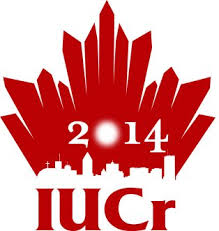2014 IUCr Congress: Sessions Relevant to Magnetic Structure
The 2014 IUCr Congress (Aug 5-12, 2014) in Montreal Canada will include many sessions focused on or relevant to the structures and properties of magnetic materials. Those organized or co-sponsored by the CMS are marked with an asterisk in the list below. Abstracts are due in early February.
Multiferroics
Keynote address (Wed 6 Aug, AM), Tsuyoshi Kimura, Osaka University, Japan
Small angle scattering for magnetism and magnetic structures*
MS-08 (Wed 6 Aug, AM), Co-chairs: Joachim Kohlbrecher, Andreas Michels
Small-angle neutron and X-ray scattering have a distinguished track record in the study of magnetism and magnetic structures. This session will focus on recent studies and opportunities for SAS. Topics will include ferrofluids, flux-line lattices, superconductivity, skyrmions, and the application of neutron polarisation (incident and analysis).
Magneto-structural relationships in molecular compounds*
MS-18 (Thu 7 Aug, AM), Co-chairs: Andrea Cornea, Barbara Sieklucka
Relations between structure and magnetic ordering / magnetic anisotropy in molecular magnets. Understanding magnetic interactions in molecular compounds (intra and inter-molecular interaction.
Commensurate & incommensurate multiferroics and magnetoelectrics: structure and properties*
MS-26 (Thu 7 Aug, PM), Co-chairs: Radoslaw Przenioslo, Hiroyuki Kimura
Progress in understanding the connection between crystal structures, commensurate or incommensurate magnetic structures and electrical polarization (or magnetoelectric tensor) in multiferroics and magnetoelectrics.
Commensurate and Incommensurate Multiferroics: Structure and Properties*
Keynote address (Thu 7 Aug, PM), Laurent Chapon, Institut Laue-Langevin, France
Symmetry constraints in magnetic structure determination: experiment and theory*
MS-33 (Fri 8 Aug, AM), Co-chairs: Branton Campbell, Mois Aroyo
The superspace group formalism and representation method adapted to the description of magnetic structures and investigations of phase transitions in periodic and aperiodic crystals. The role of symmetry restrictions in the interpretation of experimental data.
Electronic and magnetic phenomena at extreme conditions*
MS-41 (Fri 8 Aug, PM), Co-chairs: Karen Friese, Karel Prokes
Spectroscopic methods for characterization of magnetic state of solids at high pressure, magnetic phase transitions, magnetic symmetry group relations and phase transition pathways, spin crossover, metal-insulator transitions, superconductivity, relaxor ferroelectric materials, Jahn-Teller effect at high pressure.
The expanding scope of crystallographic representation analysis
Keynote Address (Fri 8 Aug, PM), Branton Campbell, Brigham Young University, USA
Sixty Five Years of Magnetic Structures: Present and Future of Magnetic Crystallography
Keynote address (Sat 9 Aug, AM) Juan Rodriguez-Carvajal, Laboratoire Léon Brillouin (CEA-CNRS)
Cross-disciplinary Investigations of Structural and Magnetic Properties of Materials by Solid-State NMR and Diffraction Techniques
MS-73 (Sun 10 Aug, PM), Co-chairs: J. M. Gillet, Francis Taulelle
The MS will compare the information provided on the electronic structure of materials by different techniques such as solid state NMR, Xray, gamma, electron or neutron diffraction.
Pushing the Boundaries of Aperiodic Magnetic & Crystal Structure Solution
MS-81 (Mon 11 Aug, AM), Co-chairs: Vaclav Petricek, Walter Steurer
State-of-the-art methods for magnetic and structural solution, applicable to aperiodic crystals. Novell phase retrieval algorithms, charge flipping, set projection, maximumm entropy, etc. Different approaches for the description and characterization of magnetic and other nontrivial order in aperiodic crystals.
Structural, Electronic and Magnetic Ordering: From Fundamental Physics to Functionality
MS-90 (Mon 11 Aug, PM), Co-chairs: Yuichi Shimakawa, Paul Attfield
Charge, orbital and magnetic ordering phenomena in complex oxides and related materials, studied by X-ray and neutron scattering and other techniques.
X-ray, muon and neutron studies of magnetic structure in materials*
MS-98 (Tue 12 Aug, AM), Co-chairs: Youchi Murakami, Oksana Zaharko
Synchrotron X-rays and neutron probes are used in a complimentary fashion for a range of structure studies, such as magnetic structure. Muons are a powerful probe to detect very small local magnetic moments, complimenting the neutron and synchrotron probes for average magnetic structure. The complementary use of these probes is effective to reveal complicated magnetic structures like magnetically frustrated systems.
Frustration, topology and chirality in metals and complex oxides*
MS-105 (Tue 12 Aug, PM), Co-chairs: Taku Sato, Laurent Chapon
Skyrmions and other chiral systems (metals, oxi-selenides etc.) and the search for topological strongly correlated insulators, especially in 4d and 5d transition-metal compounds.
